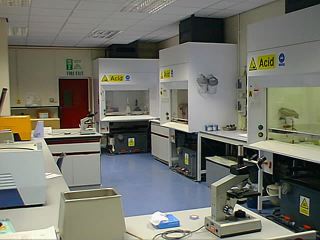

The process of retrieving palynomorphs involves 4 basic steps:
Disaggregation and dispersal is the step that separates the palynomorphs from the matrix. Different solutions are used for peat, unconsolidated, and consolidated samples. Organic solvents, such as gasoline and kerosene, are used for consolidated samples.
Chemical extraction involves three steps: demineralization, chemical conversion, and dispersion of maceration compounds.
Residue
extraction is used to rid the sample of unwanted organic material by
using oxidation - this procedure is dangerous because it may affect the
palynomorph.
Heavy density
procedure:
separates palynomorphs and rocks by density. Since the specific gravity
of palynomorphs is 1.0 - 1.5 and rocks are at least 2.0 (and quite often
higher than 3.0), using a heavy density solution such as zinc bromide (ZnBr)
or zinc chloride (ZnCl) separates the two quite efficiently.
|
|
|